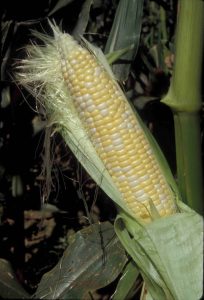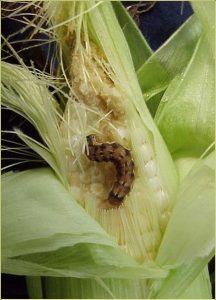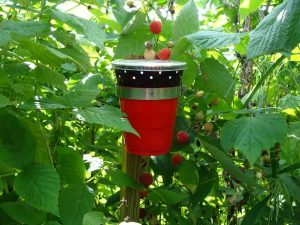Sweet Corn IPM Newsletter No. 12- September 17, 2021

Sweet Corn IPM Newsletter No. 12- September 17, 2021
Click on photos to enlarge.
COOL NIGHTS SLOW MOTH ACTIVITY
Dried Silks Mean Fields No Longer Attractive For Earworm Moth Egg Laying
This will be the final issue of the Sweet Corn IPM Newsletter for the 2021 season. I would like to thank all of the growers who participated in the program this year, and our team of IPM scouts, including Brooke Martin, Lee Lavoie and Sean McAuley. Special thanks to Caitlin Ramsay for editing and mailing the newsletter and updating our website and blog.
SITUATION
Harvest is coming to a close in many fields this week, although a few late planted fields may extend the season a little longer. Most corn remaining is no longer attractive to earworm for egg-laying (dried, brown silks), although fall armyworm could still be an issue as larvae can chew into ears from the sides. Moth counts were generally lower this week, as cooler night temperatures reduced activity, and the expected bump in populations from the recent tropical storm never occurred.

European corn borer:
Fields being sprayed for corn earworm and/or fall armyworm are not scouted for corn borer, as they will be controlled by those insecticide applications. Moth populations were low at all locations; none exceeded the 5 moths/week threshold for silking corn.

Corn earworm:
Pheromone trap moth captures were lower in most sites this week, as cooler night temperatures have slowed activity, and most fields no longer have fresh silk available for egg laying. A 4-day spray schedule was recommended for fresh silking corn in Biddeford, Cape Elizabeth, New Gloucester and one Dayton site. A 5-day spray schedule was recommended for Auburn, Corinth and one Dayton site. A 6-day spray interval was recommended for Bowdoinham and one Wells site. Fields in which the silks are brown and dry need not be sprayed for corn earworm.

Fall armyworm:
Moth counts exceeded the 3 moths/ week threshold for silking corn at sites in Auburn, Biddeford, Cape Elizabeth, and one Dayton site. All sites are on a recommended spray schedule for corn earworm, which should provide protection against fall armyworm.

Spotted wing drosophila:
Trap counts have been very high at all locations this week, meaning there is a very high threat level for any ripening fruit remaining in berry fields. Growers should maintain a tight, regular (5-7 day) spray schedule to prevent larvae from infesting fruit. For more information visit our website

Maintaining soil health for next season
Plowing down corn stalks after the season can help reduce overwintering European corn borer, but can also lead to significant soil erosion. Planting winter rye after harvest can produce enough of a vegetative cover to prevent erosion. Given the abundant rainfall this year, a modest nitrogen fertilizer application (30-50 lb. N/A) may be needed to get a good stand establishment; don’t rely on nitrogen leftover from the corn crop. Applying manure in the fall can also be useful for soil building and fertility but it should be applied and incorporated before the soil freezes, or by December 1st at the latest.
Sincerely,
David T. Handley
Vegetable & Small Fruit Specialist
Highmoor Farm Pest Management Unit
P.O. Box 179 17 Godfrey Drive
52 U.S. Route 202 Orono, ME 04473
Monmouth, ME 04259
207.933.2100 1.800.287.0279
| Location | CEW
Moths |
ECB
Moths |
FAW
Moths |
Recommendations / Comments |
|---|---|---|---|---|
| Auburn | 4 | 0 | 3 | 5-day spray interval for silking corn |
| Biddeford | 8 | 0 | 3 | 4-day spray interval for silking corn |
| Bowdoinham | 3 | 0 | 1 | 6-day spray interval for silking corn |
| Cape Elizabeth | 24 | 0 | 11 | 4-day spray interval for silking corn |
| Corinth | 6 | 0 | 1 | 5-day spray interval for silking corn |
| Dayton I | 27 | 1 | 2 | 4-day spray interval for silking corn |
| Dayton II | 5 | 0 | 12 | 5-day spray interval for silking corn |
| Monmouth | 0 | 3 | 0 | No spray recommended |
| New Gloucester | 16 | 0 | 2 | 4-day spray interval for silking corn |
| Oxford | 0 | 0 | 2 | No spray recommended |
| Wayne | 0 | 0 | 1 | No spray recommended |
| Wells I | 0 | 0 | 0 | No spray recommended |
| Wells II | 2 | 1 | 0 | 6-day spray interval for silking corn |
CEW: Corn earworm (Only fresh silking corn should be sprayed for this insect.)
ECB: European corn borer
FAW: Fall armyworm
| Moths caught per week | Moths caught per night | Spray interval |
|---|---|---|
| 0.0 to 1.4 | 0.0 to 0.2 | No spray |
| 1.5 to 3.5 | 0.3 to 0.5 | Spray every 6 days |
| 3.6 to 7.0 | 0.6 to 1.0 | Spray every 5 days |
| 7.1 to 91 | 1.1 to 13.0 | Spray every 4 days |
| More than 91 | More than 13 | Spray every 3 days |
Thresholds apply only to corn with exposed fresh silk. Lengthen spray intervals by one day if maximum daily temperature is less than 80°F.
European Corn Borer Thresholds
Whorl stage: 30% or more of plants scouted show injury.
Pre-tassel-silk: 15% or more of plants scouted show injury.
Silk: 5 or more moths caught in pheromone traps in one week.
IPM Web Pages:
Where brand names or company names are used, it is for the reader’s information. No endorsement is implied nor is any discrimination intended against other products with similar ingredients. Always consult product labels for rates, application instructions and safety precautions. Users of these products assume all associated risks.
The University of Maine is an equal opportunity/affirmative action institution.
